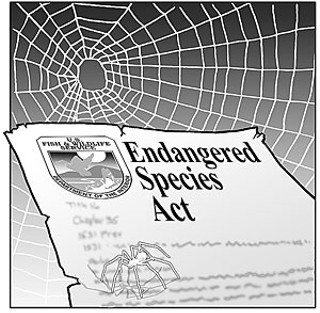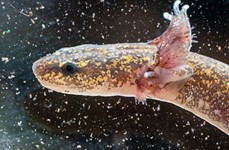Endangered Spider Spooks the Feds
Fish and Wildlife Service declines to add rare cave spider to federal endangered species list, saying C. cueva doesn't exist; critter's supporters cry foul
By Rachel Proctor, Fri., Dec. 30, 2005

The U.S. Fish & Wildlife Service announced this week it will not add a rare cave spider, Cicurina cueva, to the federal list of officially endangered species. The agency's justification? C. cueva does not actually exist. Proponents of listing the tiny, eyeless troglobite disagree, and say that by blowing off its legal responsibility to assess the threats facing the spider that lives in a pair of caves in southwest Travis County, the FWS is simply weaving a web of illegal deceit.
"The USFWS ruling on our petition is a politically motivated, scientifically brainless bag job by the Bush administration," said Mark Kirkpatrick, a UT biologist who, along with Colin Clark of Save Our Springs Alliance, wrote the petition to list C. cueva, and who also wrote the petition to list the Barton Springs Salamander. "They tried – and failed – to prevent listing the salamander, and they'll fail this time, too."
The attempt to list C. cueva has been tendentious from the get-go. When FWS receives a petition to list a species, it is required to announce within 90 days whether further study is warranted, after which it has 12 months to decide whether or not a species is endangered. On the C. cueva petition, the FWS missed the initial 90-day deadline, and ended up with a court-ordered deadline of Dec. 8 to deliver the 12-month finding. Under the 1973 Endangered Species Act, the purpose of the 12-month finding is to determine whether a species is endangered because of five factors: habitat loss, overuse, disease or predation, the inadequacy of existing regulation, or "other natural or manmade factors" affecting the species' survival.
The 12-month finding on C. cueva did not address any of these factors: instead, it detailed a $50,000 genetic study the FWS commissioned showing that the species thought to be C. cueva was actually the same species as two other closely related spiders, which provided some neat legal sleight-of-hand to deny the listing. "On the basis of this review, we find that listing C. cueva is not warranted because C. cueva does not meet the definition of a 'species' under this act," is how the official notice in the Dec. 19 Federal Register put it.
That reclassification instantly extended the known range of the spider the agency is now referring to as the "C. cueva complex" to 24 caves rather than two, a fact that suggests its fate is not quite as dire as if it lived in two caves and two caves only. However, that doesn't address the fundamental mission of the 12-month review: determining whether or not the spider – in two caves or 24 – is endangered. According to Robert Pine of the Austin FWS office, after putting all that research into mitochondrial DNA and other hifalutin' genetic taxonomy, the agency just plain didn't have the money for a threat analysis. Or the time – the agency was facing a court-ordered deadline to deliver that 12-month finding. "If it turned out that a significant number of those caves had imminent threats, it could still be a listable species," Pine said. "That kind of threat analysis hasn't been done by the Service."
The decision not to analyze threats wasn't for lack of knowledge that threat could be imminent: In comments submitted in August (after the May completion of the genetic study proposing the one-species hypothesis), SOS Alliance argued that whether the spiders were found in two, 24, or 50 caves, the whole area is in danger of cave-paving development. The group continued to advocate special protection for Flint Ridge Cave, one of the two caves described in the original petition: The group considers it one of the two most important recharge features in the Barton Springs segment of the Edwards Aquifer, and as a big, deep cave, it provides particularly prime spider habitat even if a couple dozen other less-handsome caves do exist. Flint Ridge Cave also faces the most immediate threat: It is adjacent to the planned extension of SH 45, putting it at ground zero for the kind of water pollution, noise, and general disturbance that degrade and destroy ecosystems. (To add insult to injury, the area surrounding the cave was originally purchased by the city as part of the Balcones Canyonlands Conservation Plan, but Travis County subsequently acquired its right-of-way for the highway.)
The battle is by no means over – Pine at FWS said with a sigh that he expected a threat analysis would be forthcoming "if we got sued." However, an anti-ESA climate at the federal level – as evidenced by the ESA overhaul passed by the House that would compensate property owners for lost hypothetical profits from habitat protection – suggests the fight will be long and it will not be easy. After all, only 17 species were listed as endangered in the first five years of the Bush administration, compared to 158 under four years of Bush I and 345 under eight years of Clinton.
Got something to say on the subject? Send a letter to the editor.









